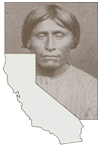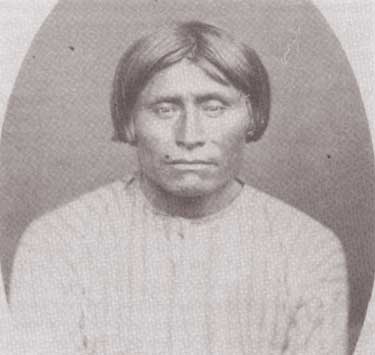![]()

Five Views: An Ethnic Historic Site Survey for California
MENU
Introduction
pre-1769
1769-1848
1849-1879
1880-1904
1905-1933
1934-1964
1965-1980
Historic Sites
Selected References

A History of American Indians in California:
HISTORIC SITES
Captain Jack's Stronghold
(Lava Beds National Monument)
Modoc County
Captain Jack's Stronghold, part of Lava Beds National Monument, is located at the Perez turnoff, off Highway 139 between Tule Lake and Canby, California. The lava beds made an outstanding stronghold for the Modocs because of the rough terrain, rocks that could be used in fortification, and irregular pathways to evade pursuers. The area originally served as a hunting and gathering area. It is now a national monument managed by the National Park Service.
In 1869, Ulysses S. Grant became president of the United States. During his term of office, there existed conflicting philosophies and policies for dealing with Indian affairs. The policies came from three distinct sources: first, Interior Department officials believed that Indian Agents were more important than Indians; second, the War Department believed it was cheaper to feed Indians than to shoot them; and third, private citizens believed that if Indians adopted Christianity, they would change their habits, folkways, and economic system, and then become peaceable and self-reliant. Grant often referred to the third policy as his "Quaker Policy." Not knowing which of these policies to use, Grant implemented all three. The result was disastrous. Under these conflicting philosophies, the Modoc Indians were forced to move onto the Klamath Indian Reservation on Upper Klamath Lake in Oregon in 1869.
The Klamath Indians believed that they had allowed the Modocs to relocate onto their land. Moreover, they felt that all resources on the land remained theirs by ancestral right. The retention of land rights was a continuing source of agitation between Klamaths and Modocs. In addition, social conditions at Klamath were distressing. Against official orders, army officers gambled with Indians, often winning as many as 20 or 30 horses from Indian men. Army officers at Klamath also quite openly took Indian women, even from their husbands. Once their wives had been prostituted this way, husbands often refused to take them back. Meanwhile, the agents encouraged Indians to become herdsmen and farmers and to live in log cabins instead of in their traditional wickiups.
Captain Jack watched life at Klamath and became convinced that he should live the way his ancestors had. Others in his band agreed with him and so they returned to their land on Lost River. All they wanted was the right to their traditional homeland. Late in 1869, messengers went to Lost River to ask Jack to come back to Klamath to discuss the possibility of his returning permanently to the reservation. He refused to leave Lost River and told the messengers that people would have to come to him if they wanted to talk.
In the spring of 1871, Jack employed a Klamath Indian shaman to care for a sick Modoc child. He paid the fees in advance and a contract was entered into. Among the Modoc, this type of contract was understood as a guarantee to heal. In the event of failure, the doctor's life was to be forfeited. The sickness of the child was more serious than originally thought, and she died. In accordance with custom, Captain Jack killed the Klamath shaman for inefficiency. Friends of the shaman informed the local sheriff of the murder, and asked for Jack's arrest. Under the provisions of the "Great Treaty" of 1864, Indians were bound never to murder again; therefore, the sheriff issued a warrant for Jack's arrest. Jack, meanwhile, traveled to Yreka to see attorney Elisha Steele, who wrote a letter for him to the Indian Agent advising against his arrest on spiritual and cultural grounds. The agent accepted Steele's advice and dropped the charges against Jack. Settlers in the area nevertheless used the murder charge to discredit Jack.
In November 1872, soldiers and settlers attacked Captain Jack's camp on Lost River. After the battle, about 50 Modocs fled to the strategic position of the lava beds. Jack lived in the stronghold and successfully defended it for about one year. The first battle for the stronghold took place in January 1873, and the second in April 1873. During the repeated attacks by soldiers and settlers, Captain Jack was able to use the lava beds to his advantage, and only a few people were ever allowed to enter the stronghold to negotiate with him. After several unsuccessful attempts at resolving the whole problem, negotiators sent word back to Washington that the Modocs must be defeated militarily. Captain Jack surrendered on June 1, 1873, and was executed along with five other Modoc men on October 3, 1873. Those remaining in Jack's band were removed to Indian territory in Oklahoma. In 1909, most surviving Modocs returned to the Klamath Reservation. It is important to note that Jack never signed a treaty, and that he defended the stronghold with only a few Indians while the number of men fighting against him at times exceeded 300.

Captain Jack
NEXT> Cherokee
Last Modified: Wed, Nov 17 2004 10:00:00 pm PDT
http://www.cr.nps.gov/history/online_books/5views/5views1h11.htm
![]()
 Top
Top